National improvement framework for Scottish education: evidence report 2017
An overview of available current evidence on achievement, attainment, health and wellbeing, in Scottish education.
Key Priority: Improvement in employability skills and sustained, positive school leaver destinations for all young people
School Leaver Destinations: Main Findings
91.4% of leavers in 2015/16 were in a positive destination in March 2017 (a decrease from 92.0% for 2014/15).
'Positive destinations' include higher education, further education, training, voluntary work, employment and activity agreements. The chart below shows the percentage of leavers from 2015/16 in positive destinations in March 2017, as well as the percentage of leavers who were unemployed.
- Higher or further education: 59.7%;
- Employed: 28.7%;
- Training, activity agreement or voluntary work: 3.0%;
- Unemployed: 7.7%; and
- Unknown: 0.9%.
School Leaver Destinations: Evidence on the Gap
96.2% of 2015/16 school leavers from the 20% least deprived areas were in a positive follow-up destination in March 2017 compared to 85.0% from the 20% most deprived areas were in positive destinations.
This gap in positive leaver destinations has decreased slightly over the past three years: from 12.9 percentage points in 2012/13 to 11.2 percentage points in 2015/16:
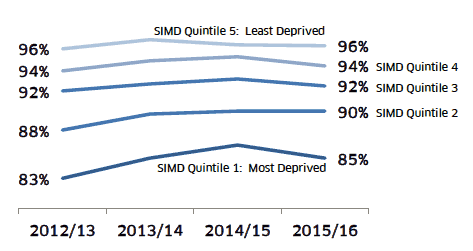
Of the various types of positive destinations, the difference is most notable for further or higher education: while 70.9% of 2015/16 school leavers from the least deprived quintile were in further or higher education in March 2017, this is the case for only 51.6% of leavers from the most deprived quintile.
More information on leaver destinations can be found in the 2017 Summary Statistics for Attainment, Leaver Destinations and Healthy Living publication.
Developing the Young Workforce
Developing the Young Workforce ( DYW) is a seven-year programme (2014 – 2021) that aims to better prepare children and young people from 3–18 for the world of work.
This programme builds on the foundations already in place as part of Curriculum for Excellence. The headline aim being to reduce youth unemployment by 40% by 2021.
The Scottish Government fulfilled this commitment four years ahead of schedule. Analysis of the latest ONS Labour Force Survey dataset from January to March shows that the level of youth unemployment excluding full-time education has fallen to 27,000 in 2017, from 52,000 in 2014, a decrease of 48.3%.
However, despite the success of DYW and the encouraging results there is more do be done to fully embed the DYW principles in the curriculum and expand the range of opportunities available to young people. We want all young people to undertake relevant work-related learning as part of their curriculum 3-18, regardless of their learning pathway, future career aspirations, gender or background.
The DYW Key Performance Indicator ( KPI) 3 is to "increase the percentage of school leavers attaining vocational qualifications at SCQF level 5 and above by 2021".
In 2015/16, 10.7% of school leavers left with one or more vocational qualifications at SCQF Level 5 or better, compared with 9.0% in 2014/15 and 7.3% in 2013/14.
During 2015/16, the percentage of school leavers attaining vocational qualifications also increased at SCQF Levels 2 to 7.
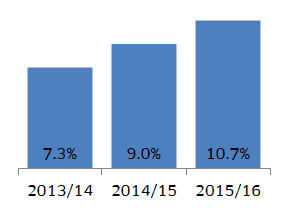
Participation Measure
In 2012, the Scottish Government made an explicit commitment to offer a place in learning or training to every 16-19 year old in Scotland who is not currently in employment, education or training. This Opportunities for All ( OfA) pledge aims to ensure all young people are supported in their path to sustainable employment.
The annual participation measure ( PM) reports on the activity of the wider 16-19 year old cohort, including those at school, and will help to inform policy, planning and service delivery and determine the impact of the OfA commitment. The measure uses the shared data set held by Skills Development Scotland ( SDS) on their Customer Support System ( CSS).
Central to the creation of the shared dataset is the sharing of information to allow partners to identify what young people are doing in 'real time' throughout their 16-19 journeys. It also allows SDS and partners to improve service delivery and provide a more tailored offer, helping to identify the right time to engage with customers.
Main Findings
The proportion of 16-19 year olds participating in education, training or employment is 91.1% in 2017, an increase of 0.7 percentage points compared to 2016.
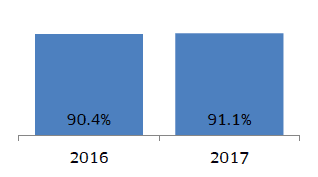
The proportion participating in education, training or employment by age in 2017 are:
- Rate for 16 year olds is 98.8%
- Rate for 17 year olds is 94.0%
- Rate for 18 year olds is 88.9%
- Rate for 19 year olds is 83.4%
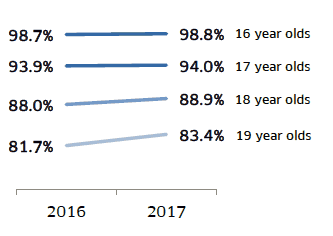
The proportion of 16-19 year olds not-participating within the annual measure is 3.7% in 2017, compare with 4.0% in 2016.
This is a decrease of 0.3 percentage points.
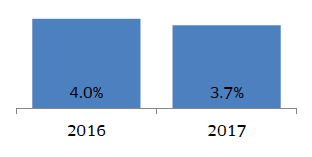
The proportion not-participating within the annual participation measure by age in 2017 are:
- Rate for 16 year olds is 1.0%
- Rate for 17 year olds is 3.9%
- Rate for 18 year olds is 5.1%
- Rate for 19 year olds is 4.5%
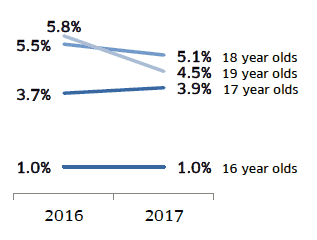
The proportion of 16-19 year olds reported as unconfirmed within the annual measure is 5.3% in 2017, compare with 5.6% in 2016.
This is a decrease of 0.3 percentage points.
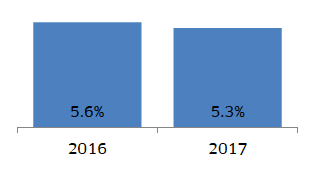
The proportion reported as unconfirmed within the annual participation measure by age in 2017 are:
- Rate for 16 year olds is 0.2%
- Rate for 17 year olds is 2.1%
- Rate for 18 year olds is 6.1%
- Rate for 19 year olds is 12.0%
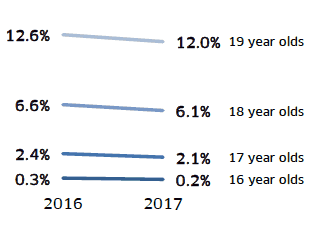
% Annual Participation of 16-19 year olds by
SIMD
Decile
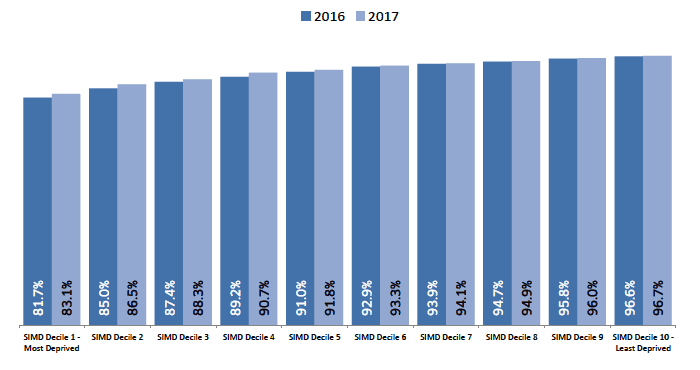
Overall, those who live in more deprived areas are less likely to be reported as participating within the annual measure than those from the less deprived areas.
There is an 11.6 percentage point difference in the participation rate between those from SIMD Quintile 1 and SIMD Quintile 5.
Participation Gap between the 20% most deprived areas (
SIMD
Quintile 1) and the 20% least deprived areas (
SIMD
Quintile 5)
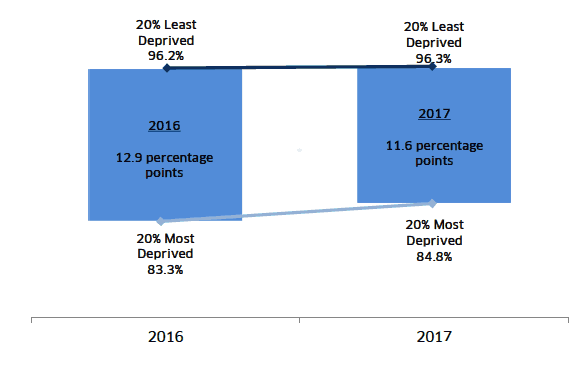
Those from the lesser deprived areas are more likely to be reported in education compared to those from more deprived areas. The proportion of 16-19 year olds reported as participating in education from the least deprived areas ( SIMD decile 10) is 83.6% compared to 61.4% for those from the most deprived areas ( SIMD decile 1), a difference of 22.2 percentage points.
Breakdown of Participating 16-19 year olds, 2017
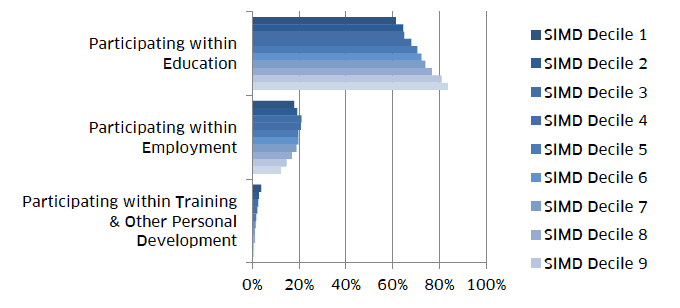
A higher proportion of 16-19 year olds from the more deprived areas are reported as unemployed seeking compared to those from the less deprived areas. For example, 4.6% of those from SIMD 1 are unemployed seeking compared to 0.5% from SIMD 10.
Breakdown of Not-Participating 16-19 year olds,
2017
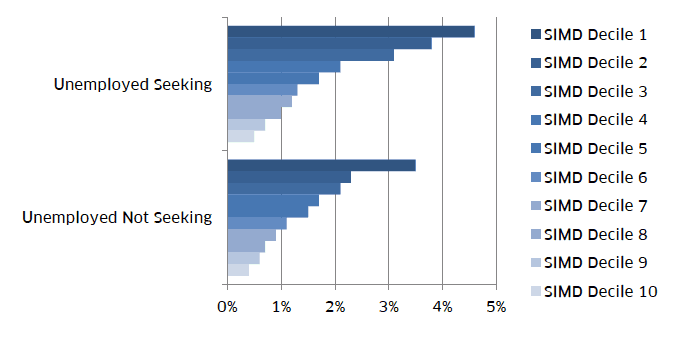
Contact
There is a problem
Thanks for your feedback